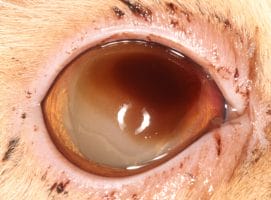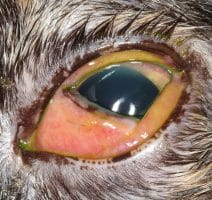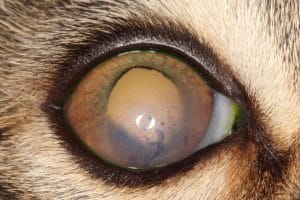Feline Eye Conditions
A quick eye exam on your pet while petting, grooming or even when relaxing on your lap can clue you into any discharge, cloudiness or inflammation of the eyes that may indicate a health problem.
When to Visit Veterinary Eye Institute
Any of the following signs are cause for a visit to the veterinarian, as they can indicate pain, infection or a disease progression:
- Dilated pupils or pupils of two different sizes
- Cloudiness or sudden change in eye color
- Unusual spots on the iris (the colored portion of the eye) or the cornea (the surface of the eye)
- Squinting, winking, or keeping the eye(s) closed
- Pawing at the eye
- Ocular discharge, excessive watering, crustiness in the corners of the eye, tear stained fur
- Visible third eyelid
What to Expect During Your Pet’s Eye Exam
When you schedule your appointment, our team will share information on how to prepare for your visit, which may include things like making sure your pet has not eaten (if fasting is required) or bringing a list of their medications.
During your pet’s consultation, our ophthalmology team will review your pet’s medical records from your family veterinarian and discuss your pet’s lifestyle and health history with you. We will perform a comprehensive eye exam on your pet by checking their tear production, measuring eye pressure, and thoroughly examining their eyelids, cornea, lens, retina, and optic nerve.
Based on our findings, your pet may need additional advanced testing. We will discuss your pet’s diagnosis and treatment plan with you and answer any questions you may have. Our team partners with your family veterinarian to provide the best treatment options for your pet.
Commonly Treated Conditions in Cats


The clinical signs of feline herpes vary, but can include:
- Sneezing
- Nasal discharge
- Lethargy
- Fever
- Anorexia
- Dermatitis (skin inflammation and/or ulcers)
- Excessive blinking or squinting
Once a cat is infected with FHV, they will usually show disease signs in two to five days (incubation period of the disease). During the incubation period, the infected cat can pass along the disease to other cats. Once the signs appear, the active infection lasts about 10 to 20 days.
Cats with FHV can develop eosinophilic keratitis, a chronic, inflammatory disease of the cornea, because of an overreaction of their immune system to the virus. Eosinophils (a type of white blood cell) invade the cornea, causing it to appear as if there are white to pink bumps on it and/or cloudiness (edema) and blood vessel ingrowth.
Medication management can preserve your cat’s vision and quality of life
There is no cure for the feline herpes virus. It behaves similarly to the human herpes virus that causes cold sores – once the virus is present, it remains in the body for life. The disease can be dormant and go through phases of being active. In many cats, being a carrier of the virus does not cause problems and they do not shed the virus multiple times. Any stressful situation for your cat, such as travel, boarding, or introducing new animals, can activate the virus.
If your cat has active FHV, your veterinarian may prescribe an antiviral medication or a steroid to help alleviate signs of the disease. To help prevent future outbreaks of the virus, your veterinarian may recommend l-lysine, an over-the-counter amino acid.
If your cat is diagnosed with eosinophilic keratitis, the medication your veterinarian will prescribe must be taken for the duration of the cat’s life. Stopping the medication can cause the disease to return, making it more difficult to control.

There are many causes of uveitis including infectious diseases, cancers, and autoimmune disease. Causes of uveitis in cats include:
- Feline Leukemia Virus (FeLV), Feline immunodeficiency virus (FIV), also known as feline AIDS), and Feline infectious peritonitis (FIP) disease complex caused by the coronavirus, all of which cannot be spread to people.
- Bartonellosis (Cat scratch fever) is caused by bacteria that can be spread to people, especially those that are young or immunosuppressed by other diseases or chemotherapy.
- Toxoplasmosis is caused by a protozoal parasite that can be spread to people, especially those that are immunosuppressed by other diseases or chemotherapy.
- Fungal infections such as Blastomycoses, Histoplasmosis, Cryptococcosis, or Coccidiomycosis.
- Parasitic disease due to intestinal parasites or heartworm disease
- Neoplasia (cancer) of the eye, or cancer of another area of the body that has spread to the eye.
- Idiopathic: Cause is unknown
Regardless of the cause, uveitis requires treatment to try to prevent secondary glaucoma, permanent blindness, and pain. Additionally, given the nature of this condition, diagnosing a specific cause of uveitis will often require special testing and the prognosis will depend on the underlying cause.
Sudden changes in vision should be considered urgent as vision loss can be permanent if not addressed quickly. Signs of visual impairment can include but are not limited to bumping into things, tripping on stairs, or appearing to have trouble finding their litter box or food bowl. There are many potential conditions and diseases that can result in acute vision changes including:
- rapid development of cataracts
- glaucoma
- retinal detachments
- inflammation of the retina or optic nerve
- severe inflammation in the front of the eye
- central nervous system disease.
The expert, compassionate team at VEI can typically identify the cause of vision loss with an eye exam. However, some diseases may require additional testing.
If your pet is experiencing significant changes in vision, we recommend scheduling an appointment as soon as possible. You can call the nearest VEI location directly or ask your family veterinarian for a referral.
We encourage you to contact your family veterinarian or the nearest emergency veterinary hospital if you feel your pet is experiencing a medical emergency.